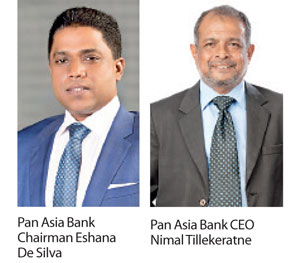28 Apr 2017 - {{hitsCtrl.values.hits}}
Mid-sized bank, Pan Asia Banking Corporation PLC, reported an after tax profit of Rs.353.4 million for the March quarter (1Q17) recording an increase of 16 percent from the same period last year.
The performance was largely supported by the increase in the fee and commission income, slightly lower tax liability and the closer tab kept on the costs. 
However, the core-banking performance became subdued in response to the tighter credit conditions remained throughout the period.
The bank’s earnings per share was Rs.3.41 by end-1Q17, slightly less than Rs.3.91 reported in the same period of 2016 due to the increase in bank’s equity resulted by the Rs.2.0 billion rights issue in March 2017, which was promptly oversubscribed.
Meanwhile, the income tax expense for the period came down by 12 percent to little under Rs.160 million for the quarter from a year ago as a result of effective tax management.
What is also notable is the fact that despite the new equity injection, the bank was able to maintain its return on equity (RoE) at 18.95 percent, which is among the highest in the industry, albeit slightly down from 19.97 percent reported three months ago.
In spite of the mounting pressure on banking sector margins as a whole, the bank was largely able to maintain its net interest margin (NIM) at 3.79 percent, higher than the industry average of around 3.4 percent although slightly down from its December’s 3.87 percent.
Speaking on the bank’s recent performance, the bank’s newly appointed Director/Chief Executive Officer Nimal Tillekeratne said this performance was a true reflection of the bank’s and ability to report consistently higher financial performance even amid challenging conditions.
“I am happy to announce our financial performance for the first quarter because the bank operated under less than favourable conditions such as rising interest rates, slowdown in demand for new loans and risk of new addition to non-performing loans,” he said.
Commenting further on the recent issue of rights, he confided that the bank could meet the minimum core-capital requirement of Rs.10 billion by end-2017 with the strong earnings forecasted for the remainder of the year.
By end-March 31, 2017, the bank had a core capital base of Rs.8.7 billion and a total capital base of Rs.10.5 billion.
Also, both Tier I and Tier II capital adequacy ratios received a boost from the recent rights issue proceeds of Rs.2.0 billion and by end-March 31, 2017, the two ratios stood at 11.07 percent and 13.83 percent, respectively, significantly up from 8.37 percent and 11.40 percent in December 2016.
The bank’s core-banking performance was impacted by the tightening monetary and fiscal conditions because higher interest rates and higher indirect taxes dampened the demand for new loans.
Although the interest income rose by a strong 36 percent to Rs.3.89 billion from a year ago, the corresponding interest expense grew by an even higher 54 percent year-on-year (YoY) to Rs.2.68 billion resulting in net interest income (NII) of Rs.1.21 billion, an increase of a modest 7.0 percent from a year earlier.
The low-cost deposit base measured by the current and savings account (CASA) ratio also declined to 19.6 percent from 20.3 percent in December as the mid-term deposits grew much faster.
Net fee and commission income acted as an important anchor to guard against the tightened NIIs as such income grew by a strong 63 percent YoY to Rs.339.95 million.
This was predominantly due to credit-related fee income and partly due to the fee income from credit cards.
As a result of productivity and efficiency enhancement activities pursued during the last four years, the bank was able to bring down its cost-to-income ratio to 54.24 percent from 56.03 percent three months ago.
Meanwhile, the return on assets also rose to 1.11 percent from 1.05 percent in December.
The staff cost rose by little under 10 percent mainly due to the increased salaries and other emoluments while the other expenses rose by 16 percent due to the generally increase in price levels and indirect taxes.
The bank is now on an aggressive staff rationalization programme, which will see excess head office staff being redeployed to the branch network, which will be expanded up to 100 within the next 18 months.
The bank’s total assets remained largely unchanged at Rs.129.12 billion during the quarter under review as the growth in both loans and deposits slowed down in response to higher interest rates.
Both loans and advances and deposits grew by little above Rs.2.0 billion to Rs.100.5 billion and Rs.93.8 billion, respectively.
The asset quality came under slight pressure due to new additions to non-performing loans (NPLs) amid slow down in loans. Therefore, the gross NPL ratio rose to 5.63 percent from 4.74 percent in December but the bank is confident that the ratio could be brought down with the appropriate strategies already in place.
26 Nov 2024 6 minute ago
26 Nov 2024 37 minute ago
26 Nov 2024 3 hours ago
26 Nov 2024 3 hours ago
26 Nov 2024 3 hours ago